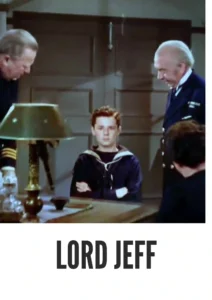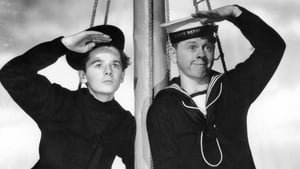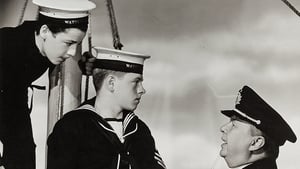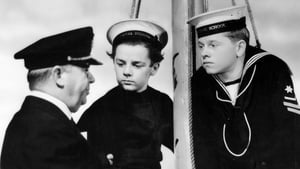Contact: info@alwanfilm.com
Video Sources 0 Views
- Lord Jeff 1938 Colorized

Synopsis
Table of Contents
ToggleLord Jeff 1938 Colorized Review: A Coming-of-Age Drama with Heart and Heritage

Introduction
Lord Jeff (1938), directed by Sam Wood, stands as a classic example of 1930s coming-of-age films, capturing the challenges and transformations of youth with a unique blend of heart, adventure, and life lessons. Released by MGM, Lord Jeff brings together a talented cast, led by Freddie Bartholomew and Mickey Rooney, in a narrative that touches upon themes of redemption, camaraderie, and the trials of adolescence. The film’s story is enriched by its exploration of heritage and personal growth, as it brings audiences into the world of young Jeff, an orphan with a penchant for trouble who discovers both friendship and purpose. This article will explore the impactful performances, narrative nuances, and timeless appeal of Lord Jeff, examining the reasons it continues to resonate with audiences even after decades.
Check The Full Colorized Movies List
Check Our Colorized Movies Trailer Channel
Understanding Lord Jeff 1938 Colorized: Director, Cast, and Genre
Director’s Vision for Lord Jeff
Sam Wood, a filmmaker known for his versatility and skill in capturing the emotional essence of his characters, directed Lord Jeff with a keen eye for both realism and sentimentality. Wood’s direction reflects his commitment to creating stories that resonate on a deeply human level, giving space for the characters to grow and interact naturally within the plot. With Lord Jeff, Wood crafts a coming-of-age story that is as much about finding one’s identity as it is about the struggle to belong and earn respect. This vision brought a dynamic layer to the film, making it memorable as both a family-friendly adventure and a reflective story on youth and redemption.
The Iconic Performance of Actors
The cast of Lord Jeff boasts remarkable young talent, led by Freddie Bartholomew in the titular role. Bartholomew’s portrayal of Jeff is both endearing and layered, capturing the struggles and stubbornness of a young boy who masks vulnerability with bravado. As an actor, Bartholomew had a reputation for mature, nuanced performances even as a child, and his portrayal of Jeff is no exception.
Opposite Bartholomew is Mickey Rooney, who plays Terry, a streetwise but loyal friend who helps Jeff find his way. Rooney’s natural charisma and humor provide the perfect foil to Bartholomew’s more reserved performance, creating a compelling on-screen partnership that adds depth to the story. The chemistry between the two young actors is a highlight of the film, contributing to its emotional impact and making the friendship between Jeff and Terry feel authentic and meaningful.
Exploring the Genre
Lord Jeff fits within the coming-of-age genre, with elements of drama and adventure that cater to audiences of all ages. Films of this genre often explore the growth and challenges faced by young characters, and Lord Jeff is no exception. The film’s emphasis on friendship, redemption, and self-discovery places it firmly within the coming-of-age tradition while also offering themes of adventure and personal struggle that resonate with viewers. The inclusion of both drama and adventure elements sets Lord Jeff apart as a film that appeals to both young and adult audiences.
Exploring the World of Lord Jeff 1938 Colorized: Plot and Characters
Detailed Synopsis
Lord Jeff follows the story of a young English boy named Jeff (played by Freddie Bartholomew), who finds himself in trouble after being caught in a series of petty crimes. Jeff, an orphan with a troubled past, is sent to a training ship for boys, where he meets Terry (Mickey Rooney) and other boys who are also seeking a better life.
As Jeff tries to navigate his new environment, he initially clashes with the rules and routines of the training ship. However, through the camaraderie of his fellow trainees and the guidance of the ship’s leaders, Jeff begins to change. He learns valuable lessons about loyalty, respect, and friendship, ultimately discovering his potential and becoming a part of the team. Key moments in the film highlight Jeff’s struggles, his growth, and his deepening bonds with the other boys. The story culminates in Jeff’s transformation from a wayward youth into a responsible young man with a newfound sense of purpose.
Complex Protagonist and Memorable Supporting Characters
Jeff’s character arc is one of the film’s strongest elements. His initial resistance to authority and penchant for mischief make him a challenging protagonist, but his growth and development are deeply rewarding to watch. Through his experiences and friendships, Jeff’s character undergoes a significant transformation, evolving from a troubled boy into a respectable young man with a sense of duty and integrity.
Supporting characters such as Terry (played by Rooney) bring a sense of warmth and humor to the film. Terry’s friendship with Jeff is central to the narrative, highlighting the importance of loyalty and camaraderie. The leaders on the training ship, including various mentors and authority figures, also play crucial roles in shaping Jeff’s journey, providing guidance and discipline that help him find his path.
The Art of Film Colorization
Understanding the Process of Film Colorization
Although Lord Jeff (1938) was originally filmed in black and white, its subsequent colorized version has added a new layer to the film’s visual appeal. Film colorization is a process that involves digitally adding color to black-and-white films. Early colorization methods were labor-intensive and required frame-by-frame manual coloring. Today, digital technology has streamlined the process, allowing for greater precision and more vibrant results.
The colorization of Lord Jeff was carefully executed to preserve the film’s historical context while enhancing the overall viewing experience. The colors bring out details that were not as apparent in the black-and-white version, such as the uniforms of the boys on the training ship and the natural beauty of the film’s outdoor settings.
Development Over Time
Colorization technology has come a long way since its inception, with advances in digital techniques that allow for more lifelike colors and improved accuracy. Initially, colorization was met with skepticism, as early techniques often produced unnatural hues. However, modern colorization processes are capable of producing colors that closely match the historical period, resulting in a more authentic and enjoyable viewing experience.
Early Colored Films: A Brief History
Emergence of Early Colored Techniques
The journey toward color in cinema began in the early 1900s, with methods such as hand-tinting, which involved manually painting individual frames. By the 1930s, technological advancements led to the development of processes like Technicolor, which allowed for full-color films with rich, vibrant hues. This revolutionized the film industry, as audiences could now experience movies in a way that felt closer to real life.
Lord Jeff was one of many films from the 1930s that was later colorized to take advantage of these advancements. This process allowed the film to reach new audiences and provided an opportunity to reintroduce the story with enhanced visual appeal.
Lord Jeff 1938 and Its Early Colored Version
The Decision to Release in Color
The decision to colorize Lord Jeff (1938) was made to offer a fresh experience for modern viewers. By adding color, the creators hoped to make the film more accessible and visually engaging. The colorized version allows viewers to appreciate the details of the film’s sets and costumes in a new way, adding depth to the scenes and bringing the story to life.
Impact on the Visual Narrative
The addition of color enhances the film’s visual narrative, providing a sense of realism that was not possible in the original black-and-white release. The colors add richness to the settings, such as the training ship and the boys’ uniforms, which play a significant role in the story. While some viewers may prefer the classic black-and-white aesthetic, the colorized version offers a different perspective that can deepen one’s appreciation for the film’s artistic elements.
The Debate Over Film Colorization
Controversy Surrounding Colorization
Colorization has been a subject of debate within the film industry, with some arguing that it can alter a film’s original artistic intent. Critics believe that black-and-white films were crafted with specific lighting and shading techniques that are compromised by the addition of color. They also argue that colorization may detract from a film’s historical authenticity.
On the other hand, proponents of colorization argue that it can attract new viewers and bring fresh life to classic films. For many, colorized versions provide a more immersive experience, making the story feel more relevant and accessible.
Examining Lord Jeff 1938 as an Early Colored Film
Enhancement or Distraction?
The colorization of Lord Jeff offers an opportunity to assess whether colorization enhances or distracts from the viewing experience. For many, the addition of color brings out details in the costumes and sets, making the film feel more vibrant and lively. However, some purists may feel that the colorization detracts from the film’s original tone, which was carefully crafted through black-and-white cinematography.
Ultimately, whether colorization enhances or distracts from the film’s experience depends on individual preference. Both versions of Lord Jeff offer unique perspectives, allowing viewers to choose the format that best suits their tastes.
Influence and Legacy: Lord Jeff 1938 Colorized’s Impact on Cinema
Legacy in the Coming-of-Age Genre
Lord Jeff left a lasting impact on the coming-of-age genre, inspiring future films that explore similar themes of friendship, redemption, and self-discovery. The film’s portrayal of young characters facing real-world challenges set a precedent for later coming-of-age stories, which continue to explore the complex journey of growing up.
The film’s success demonstrated the appeal of character-driven narratives that focus on personal growth and transformation. Lord Jeff remains a valuable contribution to the genre, as it paved the way for future films that seek to address the trials and triumphs of youth.
Director’s Cinematic Legacy: Beyond Lord Jeff 1938 Colorized
Sam Wood’s Influence on Filmmaking
Sam Wood’s influence extended beyond Lord Jeff, as he went on to direct a variety of notable films across different genres. Known for his ability to work with actors and create emotionally resonant stories, Wood left a significant mark on both American cinema and the coming-of-age genre. His work in Lord Jeff demonstrates his skill in crafting characters with depth and humanity, making the film a memorable piece in his filmography.
Themes Explored in Lord Jeff 1938 Colorized
Darkness, Morality, and Redemption
Lord Jeff explores themes of redemption and moral growth, as Jeff’s journey reflects the challenges of overcoming one’s past and finding a place in society. The film addresses complex issues such as loyalty, friendship, and integrity, all of which are central to Jeff’s transformation.
Reception and Controversy Surrounding Lord Jeff 1938 Colorized
Initial Reviews and Audience Reactions
Upon its release, Lord Jeff was well-received by audiences and critics alike. The performances of Bartholomew and Rooney were particularly praised, as was the film’s heartfelt story. However, the colorization of the film generated mixed reactions, with some viewers appreciating the visual enhancement and others preferring the original black-and-white format.
Where to Watch Lord Jeff 1938 Colorized Online
Lord Jeff is available for streaming on platforms such as Amazon Prime Video and Turner Classic Movies. Both the black-and-white and colorized versions can be found online, allowing viewers to choose their preferred viewing experience.
FAQs About Lord Jeff 1938 Colorized
Q: Who starred in Lord Jeff (1938)? A: The film stars Freddie Bartholomew and Mickey Rooney, both of whom deliver memorable performances.
Q: What themes are explored in Lord Jeff (1938)? A: The film addresses themes of redemption, friendship, and personal growth.
Conclusion
Lord Jeff (1938) remains a compelling story of youth and transformation, brought to life by Freddie Bartholomew and Mickey Rooney. Through the colorized version, the film continues to captivate new audiences, showcasing its timeless appeal.












